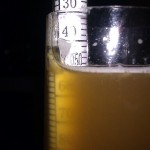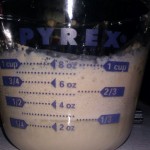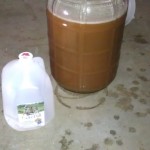Autumn brings the harvest and for me, at least for the past few years, cider making.
Like anything, it took me a few tries to make a cider that I really liked.
The New England version I like, but it can be boozy. I made a cran-cider that was ok but it got very tart over time in the bottle.
The ciders that I have liked the most have been the ones that were fortified a bit with some simple sugar and fermented with a neutral English ale yeast.
This year, the recipe was simplified. No blends of different sugars (white, brown, molasses, etc.) and no special ingredients like raisins or oak conditioning.
I went back to Cider Hill Farms in Amesbury, MA to buy the pressed apple juice. It’s very good even before fermentation so I bought 5 gallons – one for drinking now.
The rest of the juice went into the recipe:
4 gallons of pressed apple juice
1.5 pounds of local honey
2 teaspoons of pectic enzyme
2 teaspoons of tannin
1 tablespoon of acid blend
2 teaspoons of yeast nutrient
1 packet of Danstar Nottingham yeast
The pressed apple juice I bought was not pasteurized and had no preservatives. It was stored in a refrigerator at the farm store (naturally) so I had to let it warm up to around 60 degrees F before I started the process. While the juice was sitting there on my basement floor, I heated up some water and put the honey containers into the pot.
While the juice and honey were getting warmer, I proofed the one packet of yeast. By the time the yeast was ready, the other main ingredients were at temperature.
I mixed the apple juice, honey, and the other ingredients together. I have used the pectic enzyme before and it has helped with clarification. The tannin and acid blend additions were experimental. I wasn’t sure of the quantities but I thought they were good starting points.
The yeast nutrient is crucial in cider as it is in mead to get a good fermentation going. I will be adding a little to the cider over the next two days to keep it going.
The ale yeast will leave the cider a little less dry than a champagne yeast, which I am counting on. In two weeks, the primary fermentation should be done then the conditioning phase will start. Here are some photos from the cider making day:




CG
Nice write up. We’ve done cider and apfel wine before. I’m not a huge cider drinker, but we’ve got our own apple trees so we figure we really should give it a try some year. We were just up at Citizens Cider in Burlington, VT yesterday to taste them all. They have some really interesting variations I’d like to try at home – one with a Belgian ale yeast.